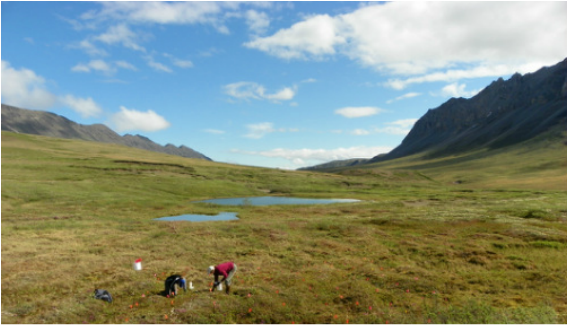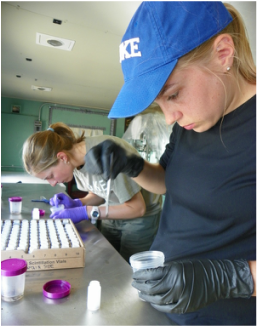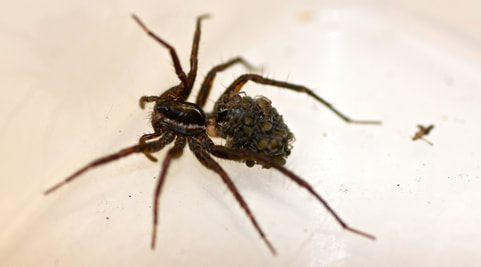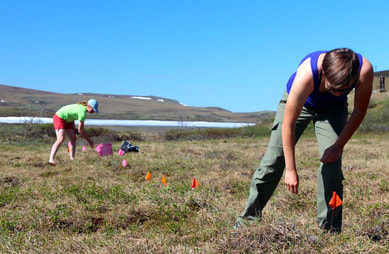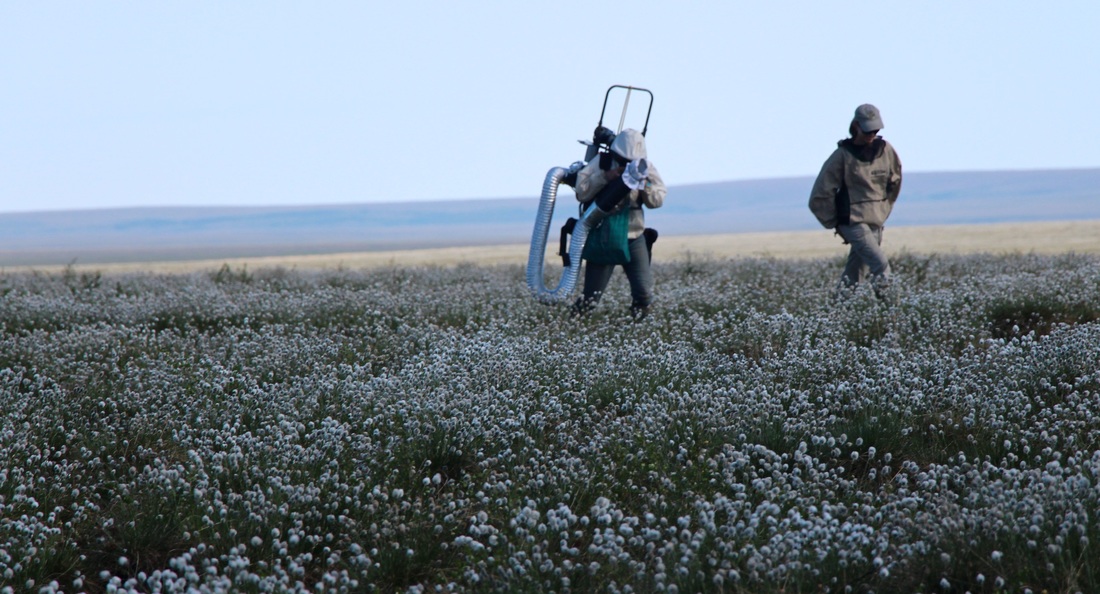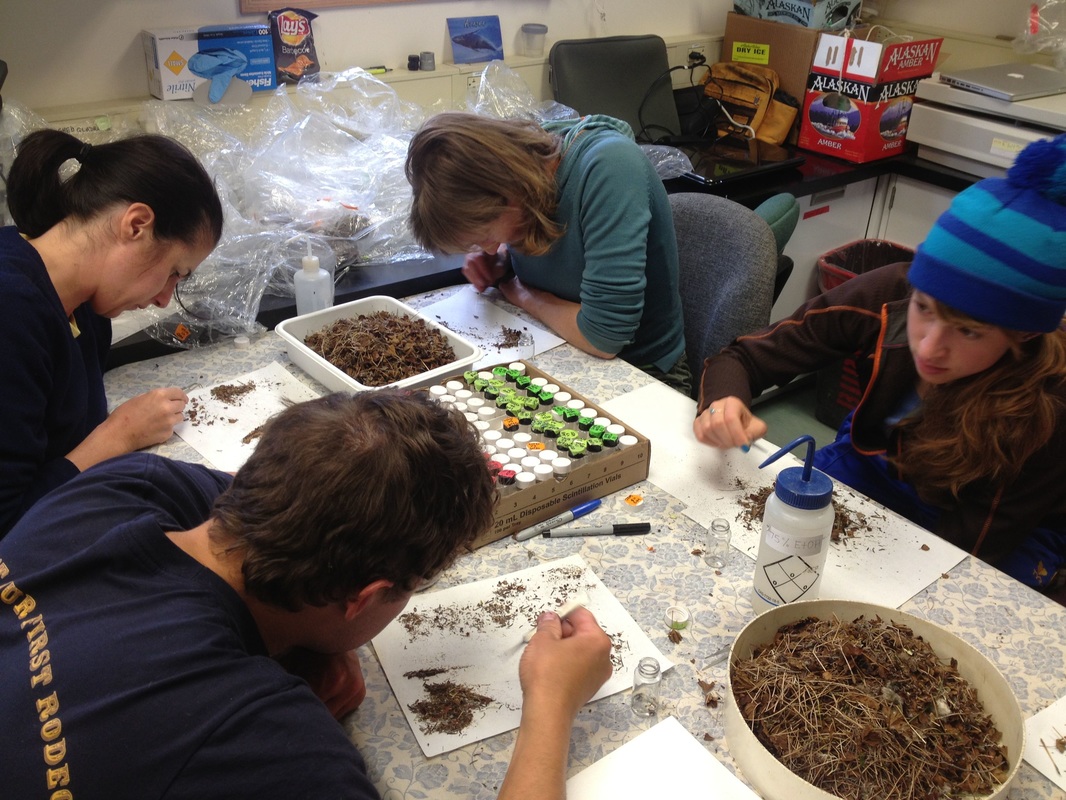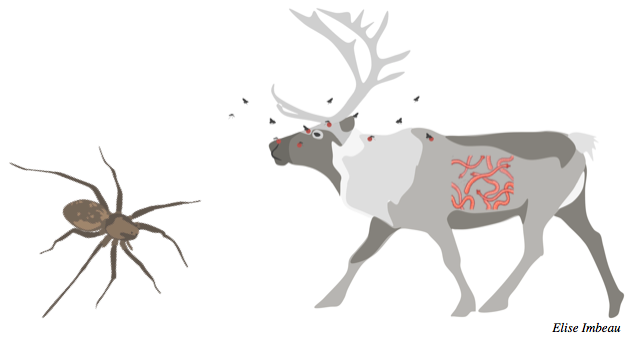
Stay tuned for updates on new projects on the roles of dung beetles and other detritivores in Texas rangeland systems, effects of sublethal parasitic infections in mice, and prey use by migratory shorebirds on the Texas Gulf Coast!
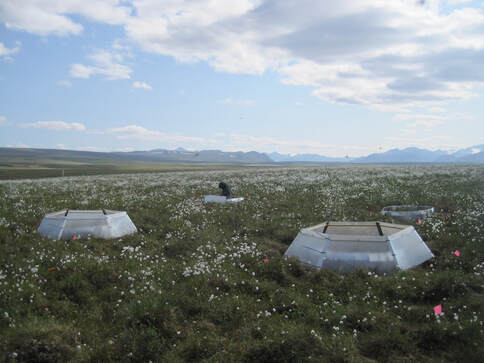
Experimental plots near Toolik Lake, Alaska.
Species and community responses to global change
To better predict when and where animal impacts are changing, we need to understand their responses to environmental change. This is a challenge, because animal responses reflect both reactions to changing abiotic conditions and interactions with other species. In some cases, there may not even be consistency in responses among closely related groups at the same location, which limits our ability to generalize across groups (recent papers on this topic: Koltz et al. 2022, Høye et al. 2021).
There is also a general lack of data on the abundance, distribution, and diversity for many groups across the Arctic (Gillespie et al. 2020), even for groups like mosquitoes and other biting insects that negatively impact the health and well-being of people and wildlife (Koltz and Culler 2021).
Cascading effects of predation in the Arctic
The Arctic is warming faster than any other biome on the planet. The dramatic environmental changes occurring there provide opportunities to understand species, community, and ecosystem responses to environmental change. Understanding these responses is critically important not just for the Arctic but also globally, because the Arctic stores nearly half of the global pool of soil organic carbon. In particular, arctic warming could increase microbially-mediated decomposition of the vast amounts of carbon stored in permafrost soils. Increased decomposition would result in higher levels of atmospheric carbon dioxide and methane, which are heat-trapping pollutant gases that endanger public health and welfare, and potentially create positive feedbacks to climate change. Decomposition rates are strongly determined by microbial community composition, and consequently, many studies have addressed the effects of climate change in the Arctic by focusing on microbial responses to warmer temperatures and greater resource availability (e.g. due to deeper permafrost thaw). Although we know that the composition and activity of the microbial community can be modified by micro- and macro- invertebrates in the soil, and that soil invertebrates themselves are regulated by generalist predators like spiders, it's unclear how microbial responses to warming in the arctic are affected by the broader food web.
Generalist-feeding spiders are among the most abundant predators globally. Their activity can indirectly influence decomposition rates, nutrient cycling, and the composition, diversity, and productivity of plant communities in temperate ecosystems. Potential shifts in spider population densities or feeding ecology as a result of climate change could have far-reaching consequences for community dynamics and ecosystem processes.
For example, our research has shown that higher densities of wolf spiders are associated with more decomposition in the tundra (Koltz et al. 2018). However, this pattern is reversed when we experimentally warm the tundra -- under warmer conditions, as wolf spider densities increase, decomposition slows due to a shift in predator-prey interactions between the wolf spiders and their Collembola prey. These results suggest that if wolf spider densities increase in the future, they could potentially help buffer some of the carbon losses from arctic soils.
To better predict when and where animal impacts are changing, we need to understand their responses to environmental change. This is a challenge, because animal responses reflect both reactions to changing abiotic conditions and interactions with other species. In some cases, there may not even be consistency in responses among closely related groups at the same location, which limits our ability to generalize across groups (recent papers on this topic: Koltz et al. 2022, Høye et al. 2021).
There is also a general lack of data on the abundance, distribution, and diversity for many groups across the Arctic (Gillespie et al. 2020), even for groups like mosquitoes and other biting insects that negatively impact the health and well-being of people and wildlife (Koltz and Culler 2021).
Cascading effects of predation in the Arctic
The Arctic is warming faster than any other biome on the planet. The dramatic environmental changes occurring there provide opportunities to understand species, community, and ecosystem responses to environmental change. Understanding these responses is critically important not just for the Arctic but also globally, because the Arctic stores nearly half of the global pool of soil organic carbon. In particular, arctic warming could increase microbially-mediated decomposition of the vast amounts of carbon stored in permafrost soils. Increased decomposition would result in higher levels of atmospheric carbon dioxide and methane, which are heat-trapping pollutant gases that endanger public health and welfare, and potentially create positive feedbacks to climate change. Decomposition rates are strongly determined by microbial community composition, and consequently, many studies have addressed the effects of climate change in the Arctic by focusing on microbial responses to warmer temperatures and greater resource availability (e.g. due to deeper permafrost thaw). Although we know that the composition and activity of the microbial community can be modified by micro- and macro- invertebrates in the soil, and that soil invertebrates themselves are regulated by generalist predators like spiders, it's unclear how microbial responses to warming in the arctic are affected by the broader food web.
Generalist-feeding spiders are among the most abundant predators globally. Their activity can indirectly influence decomposition rates, nutrient cycling, and the composition, diversity, and productivity of plant communities in temperate ecosystems. Potential shifts in spider population densities or feeding ecology as a result of climate change could have far-reaching consequences for community dynamics and ecosystem processes.
For example, our research has shown that higher densities of wolf spiders are associated with more decomposition in the tundra (Koltz et al. 2018). However, this pattern is reversed when we experimentally warm the tundra -- under warmer conditions, as wolf spider densities increase, decomposition slows due to a shift in predator-prey interactions between the wolf spiders and their Collembola prey. These results suggest that if wolf spider densities increase in the future, they could potentially help buffer some of the carbon losses from arctic soils.
Wolf spiders as a model system
Wolf spiders are increasingly being used as a model system for understanding species and population responses to arctic change. Past work showed that wolf spiders are growing larger in response to the longer summers. We've also shown that earlier springs enable wolf spiders to reproduce more (Høye et al. 2020); both of these responses to warming could result in higher population densities.
More spiders could lead to stronger predation effects. However, wolf spiders are density-dependent cannibals, so higher spider densities could actually lead to weaker effects on other prey. To complicate things further, it's unclear how wolf spiders' own predators (i.e., parasitic wasps) will respond to higher prey availability. This area of our research program is focused on understanding the abiotic and biotic drivers of variation in wolf spider population structure and trophic ecology so that we can better predict wolf spider cascading effects on ecosystems. See recent publications in the Journal of Animal Ecology on the impacts of wolf spider body size on cannibalism and juvenile abundances and in Frontiers in Ecology and Evolution on the variation in egg sac parasitism experienced by wolf spiders across Greenland.
Wolf spiders are increasingly being used as a model system for understanding species and population responses to arctic change. Past work showed that wolf spiders are growing larger in response to the longer summers. We've also shown that earlier springs enable wolf spiders to reproduce more (Høye et al. 2020); both of these responses to warming could result in higher population densities.
More spiders could lead to stronger predation effects. However, wolf spiders are density-dependent cannibals, so higher spider densities could actually lead to weaker effects on other prey. To complicate things further, it's unclear how wolf spiders' own predators (i.e., parasitic wasps) will respond to higher prey availability. This area of our research program is focused on understanding the abiotic and biotic drivers of variation in wolf spider population structure and trophic ecology so that we can better predict wolf spider cascading effects on ecosystems. See recent publications in the Journal of Animal Ecology on the impacts of wolf spider body size on cannibalism and juvenile abundances and in Frontiers in Ecology and Evolution on the variation in egg sac parasitism experienced by wolf spiders across Greenland.
Community responses to disturbance
Through several ongoing projects, we are quantifying how the structure and function of aboveground and belowground invertebrate communities are affected by global change drivers such as warming, wildfire, nutrient addition, and changes in snow melt in the Arctic and elsewhere.
See relevant publications in Royal Society Open Science, Oikos, Current Opinion in Insect Science, Ambio, and Ecology and Evolution on these topics.
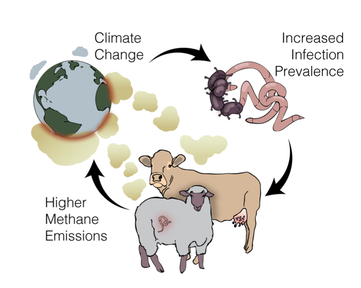
Linking parasites and ecosystems
Parasites are well-known for their negative impacts on the physiology and behavior of individual hosts, but these effects are rarely considered within the context of the broader ecosystems they inhabit. Yet in a similar way to predators, changes in parasite-host interactions can also have cascading effects on ecosystems. Understanding the links between disease ecology and ecosystem ecology is especially critical now as changing environmental conditions alter the abundance and diversity of parasitic species in both natural and managed systems across the globe. With funding from The Living Earth Collaborative at Washington University in St. Louis, our interdisciplinary working group used ungulates and their diverse parasites as a model to investigate the extent to which parasite-host interactions impact ecosystem nutrient cycling.
Small but mighty: Measuring parasites' footprints
One of our recent papers led by Vanessa Ezenwa discussed how increasing prevalence of infectious diseases could lead to higher methane emissions from ruminant livestock, thereby accelerating climate change (Ezenwa et al. 2020TREE; Press release).
Work from our group also showed pervasive yet sublethal infections by helminth parasites reduce herbivory rates by ruminants, triggering trophic cascades that impact plant communities (Koltz et al. 2022 PNAS; press release).
Members of the Parasites and Ecosystems working group include Rachel Penczykowski, Vanessa Ezenwa, Sharon Deem, Maris Brenn-White, David Civitello, Matthew Malishev, Aimée Classen, Brandon Barton, Zoë Johnson, Daniel Becker, Susan Kutz, Daniel Preston, and J. Trevor Vannatta.
Parasites are well-known for their negative impacts on the physiology and behavior of individual hosts, but these effects are rarely considered within the context of the broader ecosystems they inhabit. Yet in a similar way to predators, changes in parasite-host interactions can also have cascading effects on ecosystems. Understanding the links between disease ecology and ecosystem ecology is especially critical now as changing environmental conditions alter the abundance and diversity of parasitic species in both natural and managed systems across the globe. With funding from The Living Earth Collaborative at Washington University in St. Louis, our interdisciplinary working group used ungulates and their diverse parasites as a model to investigate the extent to which parasite-host interactions impact ecosystem nutrient cycling.
Small but mighty: Measuring parasites' footprints
One of our recent papers led by Vanessa Ezenwa discussed how increasing prevalence of infectious diseases could lead to higher methane emissions from ruminant livestock, thereby accelerating climate change (Ezenwa et al. 2020TREE; Press release).
Work from our group also showed pervasive yet sublethal infections by helminth parasites reduce herbivory rates by ruminants, triggering trophic cascades that impact plant communities (Koltz et al. 2022 PNAS; press release).
Members of the Parasites and Ecosystems working group include Rachel Penczykowski, Vanessa Ezenwa, Sharon Deem, Maris Brenn-White, David Civitello, Matthew Malishev, Aimée Classen, Brandon Barton, Zoë Johnson, Daniel Becker, Susan Kutz, Daniel Preston, and J. Trevor Vannatta.
